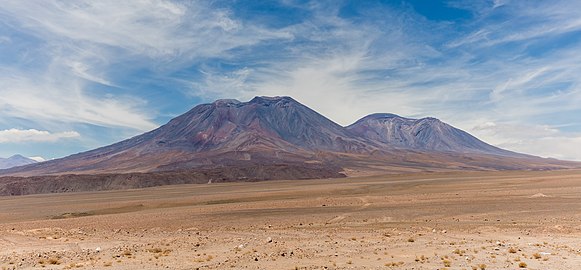San Pablo (volcano)
San Pablo was active in pre-glacial times. After that period, glaciations formed a girdle of moraines and the mountain was covered by ash fall from neighbouring San Pedro. Its central crater was eroded and a glacier formed inside. The volcano itself is formed by three groups of andesite lavas which variously contain pyroxene or hornblende; these groups are known as the Lower Group, the Middle Group and the Summit Group.
First Ascent
San Pablo was first climbed by Hans Berger (Germany) in September 1910.
Elevation
It has an official height of 6050 meters. Other data from available digital elevation models: SRTM yields 6098 metres, ASTER 6076 metres and TanDEM-X 6143 metres. The height of the nearest key col is 5302 meters, leading to a topographic prominence of 808 meters. San Pablo is considered a Mountain Subgroup according to the Dominance System and its dominance is 13.22%. Its parent peak is San Pedro and the Topographic isolation is 5.1 kilometers.
-
San Pedro volcano on the left and San Pablo volcano on the right
External links
References
- ^ "Cumbres en Zona Fronteriza: Volcán San Pablo" (in Spanish). Chilean Government - Difrol. Archived from the original on 16 March 2012. Retrieved 9 February 2012.
- ^ "San Pablo". Andes Specialists. Archived from the original on 2022-11-21. Retrieved 2020-04-12.
- ^ Le Ande Fantin. p. 105.
- ^ Evelio Echeverría (1963). "AAJ (American Alpine Journal)". AAJ (American Alpine Journal): 428.
- ^ "San Pablo". Andes Website. Archived from the original on 2013-06-29. Retrieved 2020-06-22.
- ^ rbenavente. "Biblioteca del Congreso Nacional | SIIT | Mapas vectoriales". bcn.cl. Archived from the original on 2020-06-21. Retrieved 2020-04-30.
- ^ O'callaghan, L. J.; Francis, P. W. (1986-03-01). "Volcanological and petrological evolution of San Pedro volcano, Provincia EI Loa, North Chile". Journal of the Geological Society. 143 (2): 277. Bibcode:1986JGSoc.143..275O. doi:10.1144/gsjgs.143.2.0275. ISSN 0016-7649. S2CID 129912382. Archived from the original on 2017-08-15. Retrieved 2017-07-09.
- ^ Francis, P. W.; Roobol, M. J.; Walker, G. P. L.; Cobbold, P. R.; Coward, M. (1974-01-01). "The San Pedro and San Pablo volcanoes of northern Chile and their hot avalanche deposits". Geologische Rundschau. 63 (1): 357–388. Bibcode:1974GeoRu..63..357F. doi:10.1007/BF01820994. ISSN 0016-7835. S2CID 128960834.
- ^ "IGM Chile". IGM Chile. 14 April 2020. Archived from the original on 16 April 2020. Retrieved 14 April 2020.
- ^ USGS, EROS Archive. "USGS EROS Archive - Digital Elevation - SRTM Coverage Maps". Archived from the original on 12 September 2021. Retrieved 12 April 2020.
- ^ "ASTER GDEM Project". ssl.jspacesystems.or.jp. Archived from the original on 2022-10-12. Retrieved 2020-04-14.
- ^ TanDEM-X, TerraSAR-X. "Copernicus Space Component Data Access". Archived from the original on 12 April 2020. Retrieved 12 April 2020.
- ^ "San Pablo". Andes Specialists. Archived from the original on 2022-11-21. Retrieved 2020-04-12.
- ^ "Dominance - Page 2". www.8000ers.com. Archived from the original on 2020-04-22. Retrieved 2020-04-12.
